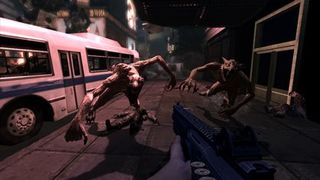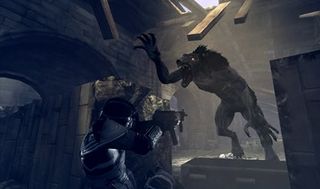Legendary's Bestiary
A detailed look at the freaks of Legendary from the game makers themselves
Werewolves
In Myth
Werewolf legends originated in ancient Greek and Norse mythology. The Greeks believed that King Lycaon was transformed into a wolf by Zeus as punishment for eating human flesh while Norse myths claim the werewolf was a son of the god Loki, who was transformed into a beast by Thor and the other Norse gods and forced to mutilate his brother.

The brutality of both of these legends taught the power of fear to religious fanatics everywhere. In Western Europe, paranoia was rampant thanks to rumors that St. Patrick and St. Natalis had the ability to morph non-Christians into wolves. Some even believed werewolves were women cursed as punishment for committing a serious sin. Even today, many Brazilians still hold the superstitious fear that the seventh son will be born a werewolf, often abandoning their seventh born.
The Truth about Werewolves
Many cultures have their own individual stories behind the werewolf’s origin but they’ve all gotten one crucial fact wrong. Werewolves are not humans that have been bitten or cursed. I am sorry to disappoint, but you’re not going to become one of these feral beast after an attack, let alone survive a vicious mauling. You’re not going to almost double in height and become faster and stronger if a werewolf wounds you; you’re going to die from exsanguination.
Werewolves are the most repulsive enemies I’ve ever faced, probably because they remind me so much of humans. These beasts live and act similarly to us, taking what they want and wrecking everything else. And yet, I’m fascinated every time I face one of these atrocities. Much like watching a lion hunting gazelle, werewolves on the prowl can be a frighteningly spectacular sight.
Sign up to the GamesRadar+ Newsletter
Weekly digests, tales from the communities you love, and more
Physical Attributes
Werewolves stand at nearly seven feet when on their hind legs. Even though they remain hunched over on all fours most of the time it’s still pretty scary to have on of these behemoths barreling down an alley right at you. Elongated arms and legs give these beasts the strength to rapidly scale walls and overpower enemies in an instant. Their razor sharp claws can tear through flesh, bone, brick and most metals, only adding to why you really shouldn’t underestimate any werewolf.

There are two variations of werewolves – Alpha and Limos – and assuming you don’t want ether one making mince-meat out of you, you’d best learn how to fight both of these beasts. Then, when you get ambushed by a pack of Alphas and Limos wolves, you can thank your lucky stars I like to write so damn much.
Alpha Werewolves are bigger, stronger and faster than the weaker Limos werewolf. The smaller, slender Limos werewolf makes up for its lack of strength with its ferocity. Always be on your toes when dealing with the lesser wolves. Taunt one of these creatures and you will be forcibly volunteering your cadaver as an object for them to hurl at other helpless victims.
In Combat
Werewolves prefer to hunt in packs, attacking by surrounding an enemy and taking turns swiping from their prey’s blind spot. Once poised on its hind legs, each wolf uses a ‘hit-and-run’ attack pattern to slowly pick away at its prey.

In the rare instance that a werewolf is alone or at a disadvantage, this opportunistic hunter will quickly climb up walls to avoid detection or defeat. Once at a higher elevation, werewolves will hurl anything they can find at their target.
A pack is made up of mostly Limos werewolves and one or more Alpha wolves. But the location of the Alpha isn’t always obvious as it sometimes lurks in the shadows, waiting to have you at your weakest. Killing enough Limos wolves will force the Alpha out of hiding – but if you’re having a shitty day, expect to brawl with two or more Alphas.
If you are lucky enough to land any damaging blows, here’s some more bad news for you: the more damage a werewolf receives, the harder it attacks. Get it angry enough and it might even attempt a highly risky pounce move that can instantly kill you. If a werewolf tries this maneuver on you, don’t run out the way. When he gets close to landing on you, quickly dodge out of the way instead. This will wear down the wolf a bit and buy you a couple of seconds to quickly kill it.

Death
Keeping your distance from werewolves is your key to survival when faced with these monsters. Even though they attack exclusively in a standing position, they don’t stand up for long. Furthermore, a werewolf’s speed makes it nearly impossible to hit with direct weapon fire. It can, however, be easily blown off its feet with explosions. Keep in mind, however, that werewolves are quick to get back up on their feet so take advantage of the little time you have to kill off a beast or find a better vantage point.

Werewolves also possess an uncanny ability to resurrect after death, which is groovy for them but not-so-good for anyone trying to kill one. Fortunately for you, God-fearing nations were onto something when they proclaimed that fire cleanses evil. Fire-based weapons are most effective against werewolves. Torch a werewolf and you’ve almost completely crippled its mobility. The wolf will become slower and weaker the longer it remains ablaze.
However, decapitation is your only guarantee that a werewolf is dead. So if a werewolf you just gunned down is getting back on its feet, quickly behead it otherwise that same werewolf will be enjoying its playtime with your innards very soon.
Oct 31, 2008
GamesRadar+ was first founded in 1999, and since then has been dedicated to delivering video game-related news, reviews, previews, features, and more. Since late 2014, the website has been the online home of Total Film, SFX, Edge, and PLAY magazines, with comics site Newsarama joining the fold in 2020. Our aim as the global GamesRadar Staff team is to take you closer to the games, movies, TV shows, and comics that you love. We want to upgrade your downtime, and help you make the most of your time, money, and skills. We always aim to entertain, inform, and inspire through our mix of content - which includes news, reviews, features, tips, buying guides, and videos.

Oh, that's why the Stellar Blade devs were terrified by demo players: one fan's spent "about 60 hours" maxing Eve's skill tree before the action RPG is even out

A new Taylor Swift song mentions GTA, but some remember it mentioning Baldur's Gate 3, Final Fantasy 14, and more in hilarious Twitter trend
Most Popular


